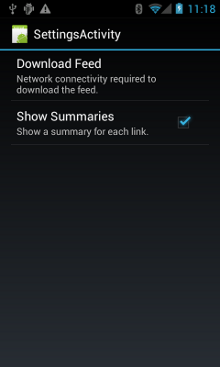- 序言
- 1. Android入门基础:从这里开始
- 2. Android分享操作
- 3. Android多媒体
- 4. Android图像与动画
- 5. Android网络连接与云服务
- 6. Android联系人与位置信息
- 7. Android可穿戴应用
- 8. Android TV应用
- 9. Android企业级应用
- 10. Android交互设计
- 11. Android界面设计
- 12. Android用户输入
- 13. Android后台任务
- 14. Android性能优化
- 15. Android安全与隐私
- 16. Android测试程序
- Published using GitBook
管理网络的使用情况
编写:kesenhoo - 原文:http://developer.android.com/training/basics/network-ops/managing.html
这一课会介绍如何细化管理使用的网络资源。如果我们的程序需要执行大量网络操作,那么应该提供用户设置选项,来允许用户控制程序的数据偏好。例如,同步数据的频率,是否只在连接到 WiFi 才进行下载与上传操作,是否在漫游时使用套餐数据流量等等。这样用户才不大可能在快到达流量上限时,禁止我们的程序获取后台数据,因为他们可以精确控制我们的 app 使用多少数据流量。
关于如何编写一个最小化下载与网络操作对电量影响的程序,请参考:优化电池寿命和高效下载。
检查设备的网络连接
设备可以有许多种网络连接。这节课主要关注使用 Wi-Fi 或移动网络连接的情况。关于所有可能的网络连接类型,请看 ConnectivityManager。
通常 Wi-Fi 是比较快的。移动数据通常都是需要按流量计费,会比较贵。通常我们会选择让 app 在连接到 WiFi 时去获取大量的数据。
在执行网络操作之前,检查设备当前连接的网络连接信息是个好习惯。这样可以防止我们的程序在无意间连接使用了非意向的网络频道。如果网络连接不可用,那么我们的应用应该优雅地做出响应。为了检测网络连接,我们需要使用到下面两个类:
- ConnectivityManager:它会回答关于网络连接的查询结果,并在网络连接改变时通知应用程序。
- NetworkInfo:描述一个给定类型(就本节而言是移动网络或 Wi-Fi)的网络接口状态。
这段代码检查了 Wi-Fi 与移动网络的网络连接。它检查了这些网络接口是否可用(也就是说网络是通的)及是否已连接(也就是说网络连接存在,并且可以建立 socket 来传输数据):
private static final String DEBUG_TAG = "NetworkStatusExample";
...
ConnectivityManager connMgr = (ConnectivityManager)
getSystemService(Context.CONNECTIVITY_SERVICE);
NetworkInfo networkInfo = connMgr.getNetworkInfo(ConnectivityManager.TYPE_WIFI);
boolean isWifiConn = networkInfo.isConnected();
networkInfo = connMgr.getNetworkInfo(ConnectivityManager.TYPE_MOBILE);
boolean isMobileConn = networkInfo.isConnected();
Log.d(DEBUG_TAG, "Wifi connected: " + isWifiConn);
Log.d(DEBUG_TAG, "Mobile connected: " + isMobileConn);
请注意我们不应该仅仅靠网络是否可用来做出决策。由于 isConnected() 能够处理片状移动网络(flaky mobile networks),飞行模式和受限制的后台数据等情况,所以我们应该总是在执行网络操作前检查 isConnected()。
一个更简洁的检查网络是否可用的示例如下。getActiveNetworkInfo() 方法返回一个 NetworkInfo 实例,它表示可以找到的第一个已连接的网络接口,如果返回 null,则表示没有已连接的网络接口(意味着网络连接不可用):
public boolean isOnline() {
ConnectivityManager connMgr = (ConnectivityManager)
getSystemService(Context.CONNECTIVITY_SERVICE);
NetworkInfo networkInfo = connMgr.getActiveNetworkInfo();
return (networkInfo != null && networkInfo.isConnected());
}
我们可以使用 NetworkInfo.DetailedState,来获取更加详细的网络信息,但很少有这样的必要。
管理网络的使用情况
我们可以实现一个偏好设置的 activity ,使用户能直接设置程序对网络资源的使用情况。例如:
- 可以允许用户仅在连接到 Wi-Fi 时上传视频。
- 可以根据诸如网络可用,时间间隔等条件来选择是否做同步的操作。
写一个支持连接网络和管理网络使用的 app,manifest 里需要有正确的权限和 intent filter。
manifest 文件里包括下面的权限:
android.permission.INTERNET——允许应用程序打开网络套接字。
android.permission.ACCESS_NETWORK_STATE——允许应用程序访问网络连接信息。
我们可以为 ACTION_MANAGE_NETWORK_USAGE action(Android 4.0中引入)声明 intent filter,表示我们的应用定义了一个提供控制数据使用情况选项的 activity。ACTION_MANAGE_NETWORK_USAGE 显示管理指定应用程序网络数据使用情况的设置。当我们的 app 有一个允许用户控制网络使用情况的设置 activity 时,我们应该为 activity 声明这个 intent filter。在章节概览提供的示例应用中,这个 action 被
SettingsActivity类处理,它提供了偏好设置 UI 来让用户决定何时进行下载。
<?xml version="1.0" encoding="utf-8"?>
<manifest xmlns:android="http://schemas.android.com/apk/res/android"
package="com.example.android.networkusage"
...>
<uses-sdk android:minSdkVersion="4"
android:targetSdkVersion="14" />
<uses-permission android:name="android.permission.INTERNET" />
<uses-permission android:name="android.permission.ACCESS_NETWORK_STATE" />
<application
...>
...
<activity android:label="SettingsActivity" android:name=".SettingsActivity">
<intent-filter>
<action android:name="android.intent.action.MANAGE_NETWORK_USAGE" />
<category android:name="android.intent.category.DEFAULT" />
</intent-filter>
</activity>
</application>
</manifest>
实现一个首选项 Activity
正如上面 manifest 片段中看到的那样,SettingsActivity 有一个 ACTION_MANAGE_NETWORK_USAGE action 的 intent filter。SettingsActivity 是 PreferenceActivity 的子类,它展示一个偏好设置页面(如下两张图)让用户指定以下内容:
- 是否显示每个 XML 提要条目的总结,或者只是每个条目的一个链接。
- 是否在网络连接可用时下载 XML 提要,或者仅仅在 Wi-Fi 下下载。


Figure 1. 首选项 activity
下面是 SettingsActivity。请注意它实现了 OnSharedPreferenceChangeListener。当用户改变了他的偏好,就会触发 onSharedPreferenceChanged(),这个方法会设置 refreshDisplay 为 true(这里的变量存在于自己定义的 activity,见下一部分的代码示例)。这会使得当用户返回到 main activity 的时候进行刷新:
(请注意,代码中的注释,不得不说,Googler 写的 Code 看起来就是舒服)
public class SettingsActivity extends PreferenceActivity implements OnSharedPreferenceChangeListener {
@Override
protected void onCreate(Bundle savedInstanceState) {
super.onCreate(savedInstanceState);
// Loads the XML preferences file
addPreferencesFromResource(R.xml.preferences);
}
@Override
protected void onResume() {
super.onResume();
// Registers a listener whenever a key changes
getPreferenceScreen().getSharedPreferences().registerOnSharedPreferenceChangeListener(this);
}
@Override
protected void onPause() {
super.onPause();
// Unregisters the listener set in onResume().
// It's best practice to unregister listeners when your app isn't using them to cut down on
// unnecessary system overhead. You do this in onPause().
getPreferenceScreen().getSharedPreferences().unregisterOnSharedPreferenceChangeListener(this);
}
// When the user changes the preferences selection,
// onSharedPreferenceChanged() restarts the main activity as a new
// task. Sets the the refreshDisplay flag to "true" to indicate that
// the main activity should update its display.
// The main activity queries the PreferenceManager to get the latest settings.
@Override
public void onSharedPreferenceChanged(SharedPreferences sharedPreferences, String key) {
// Sets refreshDisplay to true so that when the user returns to the main
// activity, the display refreshes to reflect the new settings.
NetworkActivity.refreshDisplay = true;
}
}
响应偏好设置的改变
当用户在设置界面改变了偏好,它通常都会对 app 的行为产生影响。在下面的代码示例中,app 会在 onStart() 方法中检查偏好设置。如果设置的类型与当前设备的网络连接类型相一致,那么程序就会下载数据并刷新显示。(例如, 如果设置是"Wi-Fi" 并且设备连接了 Wi-Fi)。
(这是一个很好的代码示例,如何选择合适的网络类型进行下载操作)
public class NetworkActivity extends Activity {
public static final String WIFI = "Wi-Fi";
public static final String ANY = "Any";
private static final String URL = "http://stackoverflow.com/feeds/tag?tagnames=android&sort=newest";
// Whether there is a Wi-Fi connection.
private static boolean wifiConnected = false;
// Whether there is a mobile connection.
private static boolean mobileConnected = false;
// Whether the display should be refreshed.
public static boolean refreshDisplay = true;
// The user's current network preference setting.
public static String sPref = null;
// The BroadcastReceiver that tracks network connectivity changes.
private NetworkReceiver receiver = new NetworkReceiver();
@Override
public void onCreate(Bundle savedInstanceState) {
super.onCreate(savedInstanceState);
// Registers BroadcastReceiver to track network connection changes.
IntentFilter filter = new IntentFilter(ConnectivityManager.CONNECTIVITY_ACTION);
receiver = new NetworkReceiver();
this.registerReceiver(receiver, filter);
}
@Override
public void onDestroy() {
super.onDestroy();
// Unregisters BroadcastReceiver when app is destroyed.
if (receiver != null) {
this.unregisterReceiver(receiver);
}
}
// Refreshes the display if the network connection and the
// pref settings allow it.
@Override
public void onStart () {
super.onStart();
// Gets the user's network preference settings
SharedPreferences sharedPrefs = PreferenceManager.getDefaultSharedPreferences(this);
// Retrieves a string value for the preferences. The second parameter
// is the default value to use if a preference value is not found.
sPref = sharedPrefs.getString("listPref", "Wi-Fi");
updateConnectedFlags();
if(refreshDisplay){
loadPage();
}
}
// Checks the network connection and sets the wifiConnected and mobileConnected
// variables accordingly.
public void updateConnectedFlags() {
ConnectivityManager connMgr = (ConnectivityManager)
getSystemService(Context.CONNECTIVITY_SERVICE);
NetworkInfo activeInfo = connMgr.getActiveNetworkInfo();
if (activeInfo != null && activeInfo.isConnected()) {
wifiConnected = activeInfo.getType() == ConnectivityManager.TYPE_WIFI;
mobileConnected = activeInfo.getType() == ConnectivityManager.TYPE_MOBILE;
} else {
wifiConnected = false;
mobileConnected = false;
}
}
// Uses AsyncTask subclass to download the XML feed from stackoverflow.com.
public void loadPage() {
if (((sPref.equals(ANY)) && (wifiConnected || mobileConnected))
|| ((sPref.equals(WIFI)) && (wifiConnected))) {
// AsyncTask subclass
new DownloadXmlTask().execute(URL);
} else {
showErrorPage();
}
}
...
}
检测网络连接变化
最后一部分是关于 BroadcastReceiver 的子类:NetworkReceiver。 当设备网络连接改变时,NetworkReceiver 会监听到 CONNECTIVITY_ACTION,这时需要判断当前网络连接类型并相应的设置好 wifiConnected 与 mobileConnected。这样做的结果是下次用户回到 app 时,app 只会下载最新返回的结果。如果 NetworkActivity.refreshDisplay 被设置为 true,app 会更新显示。
我们需要控制好 BroadcastReceiver 的使用,不必要的声明注册会浪费系统资源。示例应用在 onCreate() 中注册 BroadcastReceiver NetworkReceiver,在 onDestroy() 中销毁它。这样做会比在 manifest 里面声明 <receiver> 更轻巧。当我们在 manifest 里面声明一个 <receiver>,我们的程序可以在任何时候被唤醒,即使我们已经好几个星期没有运行这个程序了。而通过前面的办法注册NetworkReceiver,可以确保用户离开我们的应用之后,应用不会被唤起。如果我们确实要在 manifest 中声明 <receiver>,且确保知道何时需要使用到它,那么可以在合适的地方使用 setComponentEnabledSetting() 来开启或者关闭它。
下面是 NetworkReceiver 的代码:
public class NetworkReceiver extends BroadcastReceiver {
@Override
public void onReceive(Context context, Intent intent) {
ConnectivityManager conn = (ConnectivityManager)
context.getSystemService(Context.CONNECTIVITY_SERVICE);
NetworkInfo networkInfo = conn.getActiveNetworkInfo();
// Checks the user prefs and the network connection. Based on the result, decides whether
// to refresh the display or keep the current display.
// If the userpref is Wi-Fi only, checks to see if the device has a Wi-Fi connection.
if (WIFI.equals(sPref) && networkInfo != null && networkInfo.getType() == ConnectivityManager.TYPE_WIFI) {
// If device has its Wi-Fi connection, sets refreshDisplay
// to true. This causes the display to be refreshed when the user
// returns to the app.
refreshDisplay = true;
Toast.makeText(context, R.string.wifi_connected, Toast.LENGTH_SHORT).show();
// If the setting is ANY network and there is a network connection
// (which by process of elimination would be mobile), sets refreshDisplay to true.
} else if (ANY.equals(sPref) && networkInfo != null) {
refreshDisplay = true;
// Otherwise, the app can't download content--either because there is no network
// connection (mobile or Wi-Fi), or because the pref setting is WIFI, and there
// is no Wi-Fi connection.
// Sets refreshDisplay to false.
} else {
refreshDisplay = false;
Toast.makeText(context, R.string.lost_connection, Toast.LENGTH_SHORT).show();
}
}